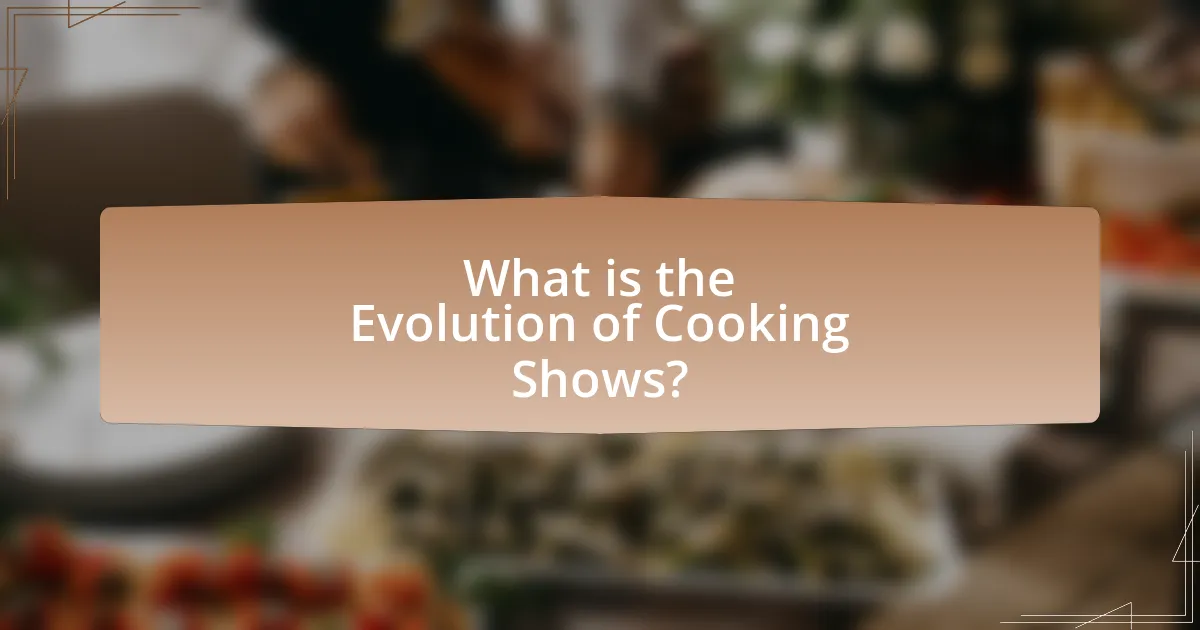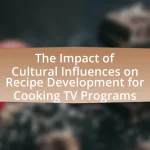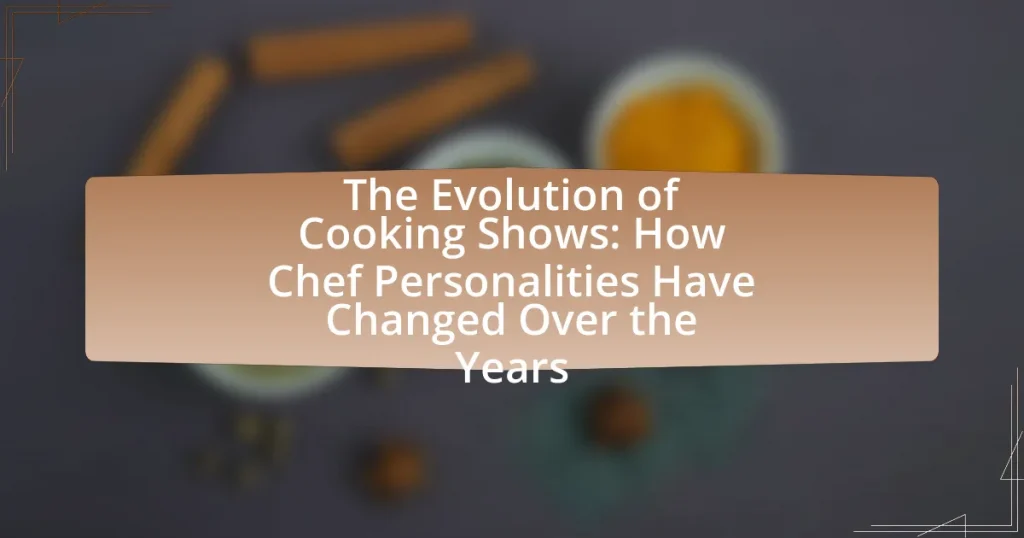The article examines the evolution of cooking shows, highlighting the transformation from basic instructional formats in the mid-20th century to today’s entertainment-driven programming featuring celebrity chefs and competitive formats. It discusses the impact of chef personalities on viewer engagement, the significance of authenticity and relatability, and how cooking shows reflect cultural changes and culinary trends. Additionally, the article explores the challenges faced by modern cooking shows, the influence of social media, and potential innovations that could shape the future of culinary programming.

What is the Evolution of Cooking Shows?
The evolution of cooking shows has transitioned from simple instructional formats to complex entertainment-driven programming. Initially, cooking shows in the 1940s and 1950s, such as “The French Chef” hosted by Julia Child, focused on teaching basic cooking techniques and recipes to home cooks. As television technology advanced and audience preferences shifted, the 1990s saw the rise of celebrity chefs like Emeril Lagasse, who infused personality and performance into cooking, making shows more engaging.
In the 2000s, reality competition formats emerged, exemplified by “Top Chef” and “MasterChef,” which combined culinary skills with dramatic storytelling, appealing to a broader audience. This shift reflected a growing interest in food culture and the culinary arts as a form of entertainment. Today, cooking shows continue to evolve with digital platforms, allowing for diverse formats and interactive viewer engagement, showcasing a wide range of culinary styles and cultural influences.
How have cooking shows transformed over the decades?
Cooking shows have transformed significantly over the decades, evolving from simple instructional programs to complex entertainment formats. In the 1970s and 1980s, cooking shows primarily focused on teaching basic culinary skills, featuring chefs like Julia Child who emphasized technique and home cooking. By the 1990s, the genre began to incorporate elements of lifestyle and personality, with chefs such as Emeril Lagasse introducing charisma and audience interaction, which increased viewer engagement.
In the 2000s, the rise of reality television led to competitive cooking shows like “Top Chef” and “MasterChef,” which not only showcased culinary skills but also created dramatic narratives around contestants. This shift reflected a broader trend in television towards character-driven storytelling. Additionally, the advent of digital platforms has allowed for niche cooking shows that cater to specific dietary preferences and cooking styles, further diversifying the genre.
Overall, cooking shows have transitioned from educational formats to multifaceted entertainment experiences, driven by changing viewer preferences and advancements in media technology.
What were the earliest cooking shows and their formats?
The earliest cooking shows include “The French Chef,” which premiered in 1963 and featured Julia Child demonstrating French cooking techniques in a straightforward, instructional format. Another early example is “Cooking with Julia,” which aired in the 1970s and focused on Child’s approachable style, emphasizing home cooking. These shows utilized a format that combined live demonstrations with detailed explanations, making culinary skills accessible to a broad audience. The success of these programs laid the groundwork for future cooking shows by establishing a format that prioritized education and engagement in the kitchen.
How did the introduction of celebrity chefs change the landscape?
The introduction of celebrity chefs transformed the culinary landscape by elevating cooking from a domestic task to a form of entertainment and cultural influence. This shift began in the 1990s with chefs like Julia Child and Emeril Lagasse, who popularized cooking shows and made them accessible to a wider audience. Their charismatic personalities and engaging presentation styles attracted viewers, leading to increased interest in cooking and food culture.
Celebrity chefs have also influenced food trends, with their endorsements and unique culinary styles shaping consumer preferences and restaurant menus. For instance, the rise of food networks and cooking competitions has created a platform for chefs to showcase their skills, resulting in a surge of interest in gourmet cooking and diverse cuisines. This phenomenon is supported by statistics showing that cooking show viewership has significantly increased, with networks like Food Network reaching millions of households.
Overall, the emergence of celebrity chefs has redefined the culinary industry, making it more dynamic and interconnected with popular culture.
What role do chef personalities play in cooking shows?
Chef personalities play a crucial role in cooking shows by influencing viewer engagement and shaping the show’s narrative. These personalities often embody distinct traits, such as charisma, expertise, and relatability, which attract audiences and enhance the entertainment value of the program. For instance, celebrity chefs like Gordon Ramsay and Julia Child have become iconic not only for their culinary skills but also for their unique presentation styles and ability to connect with viewers emotionally. Research indicates that audience connection to chef personalities can significantly impact viewer loyalty and show ratings, demonstrating that the chef’s character is as important as the cooking itself.
How do chef personalities influence viewer engagement?
Chef personalities significantly influence viewer engagement by creating relatable and memorable experiences that resonate with audiences. Engaging chef personalities often exhibit traits such as charisma, humor, and authenticity, which enhance their connection with viewers. For instance, studies show that audiences are more likely to engage with cooking shows featuring chefs who display strong emotional expressions and storytelling abilities, as these elements foster a sense of familiarity and trust. Additionally, chefs like Gordon Ramsay and Julia Child have demonstrated that distinctive personalities can lead to higher viewer retention rates, as their unique styles and approaches to cooking create a compelling narrative that keeps audiences invested in their journeys.
What traits define successful chef personalities on television?
Successful chef personalities on television are defined by charisma, culinary expertise, and strong communication skills. Charisma attracts viewers and keeps them engaged, while culinary expertise ensures credibility and showcases skill. Strong communication skills allow chefs to effectively convey their passion and knowledge, making complex techniques accessible to the audience. Research indicates that chefs who exhibit these traits often achieve higher viewer ratings and fan engagement, demonstrating the importance of personality in the success of cooking shows.
Why is the evolution of cooking shows significant?
The evolution of cooking shows is significant because it reflects changing societal values, culinary trends, and the democratization of cooking. Over the decades, cooking shows have transitioned from instructional programs focused on technique to entertainment-driven formats that emphasize personality and storytelling. For instance, the rise of celebrity chefs like Julia Child in the 1960s introduced a more approachable and engaging style, while contemporary shows often blend cooking with competition, as seen in programs like “MasterChef” and “Top Chef.” This shift not only influences how audiences perceive cooking but also impacts food culture, making culinary skills more accessible and inspiring home cooks worldwide.
How do cooking shows reflect cultural changes in society?
Cooking shows reflect cultural changes in society by showcasing evolving culinary trends, dietary preferences, and social values. For instance, the rise of health-conscious cooking shows aligns with increasing public awareness of nutrition and wellness, as seen in programs like “The Food Network’s Healthy Eats.” Additionally, the inclusion of diverse cuisines and chefs from various backgrounds highlights a growing appreciation for multiculturalism and globalization in food culture. This shift is evidenced by shows like “MasterChef,” which features contestants from different ethnicities, emphasizing inclusivity and representation. Furthermore, the popularity of cooking competitions mirrors society’s competitive nature and the desire for entertainment, illustrating how cooking has transitioned from a domestic chore to a celebrated art form.
What impact do cooking shows have on culinary trends?
Cooking shows significantly influence culinary trends by popularizing specific cuisines, techniques, and ingredients. For instance, shows like “MasterChef” and “Top Chef” have introduced viewers to diverse culinary styles, leading to increased interest in global cuisines such as Thai, Indian, and Mediterranean. According to a study published in the Journal of Culinary Science & Technology, 70% of viewers reported trying new recipes or ingredients after watching cooking shows, demonstrating their direct impact on home cooking practices. Additionally, the rise of social media platforms has amplified this effect, as viewers share their cooking experiences, further shaping culinary trends and preferences.
How have audience preferences shifted in cooking shows?
Audience preferences in cooking shows have shifted towards a greater emphasis on authenticity and relatability. Viewers increasingly favor shows that feature home cooks and amateur chefs over professional chefs, reflecting a desire for accessible cooking experiences. This trend is supported by the rise of platforms like social media, where user-generated content showcases everyday cooking, making it more relatable. Additionally, audiences are drawn to diverse cuisines and cultural representations, indicating a broader interest in global culinary traditions. This shift is evidenced by the popularity of shows like “Nailed It!” and “The Great British Bake Off,” which highlight amateur skills and celebrate imperfections, resonating with viewers seeking entertainment and connection rather than just expertise.
What are the current trends in chef personalities on cooking shows?
Current trends in chef personalities on cooking shows emphasize authenticity, relatability, and diverse backgrounds. Chefs are increasingly portrayed as approachable figures, often sharing personal stories and cultural influences that resonate with audiences. This shift is supported by the rise of social media, where chefs engage directly with fans, showcasing their personalities beyond the kitchen. Additionally, there is a growing focus on inclusivity, with chefs from various ethnicities and experiences gaining prominence, reflecting a broader societal push for representation in media. This trend aligns with viewer preferences for genuine connections and diverse narratives, enhancing the overall appeal of cooking shows.
What challenges do modern cooking shows face?
Modern cooking shows face several challenges, including audience saturation, the need for originality, and the pressure to adapt to changing viewer preferences. Audience saturation occurs as numerous cooking shows compete for attention, making it difficult for any single show to stand out. The demand for originality is heightened as viewers seek fresh content, pushing producers to innovate with formats and themes. Additionally, the rise of digital platforms has shifted viewer habits, requiring traditional cooking shows to adapt their content for online consumption, which can be a significant hurdle. These challenges necessitate that modern cooking shows continuously evolve to maintain relevance and viewer engagement.
How do social media and digital platforms affect cooking shows?
Social media and digital platforms significantly enhance the visibility and engagement of cooking shows. These platforms allow chefs and cooking shows to reach wider audiences, facilitating real-time interaction and feedback from viewers. For instance, platforms like Instagram and YouTube enable chefs to share recipes, cooking tips, and behind-the-scenes content, which can lead to increased viewer loyalty and community building. According to a 2021 survey by the National Restaurant Association, 70% of consumers reported that they are influenced by social media when deciding what to cook or eat, highlighting the direct impact of these platforms on cooking show popularity and viewer habits.
What are the common pitfalls in portraying chef personalities?
Common pitfalls in portraying chef personalities include oversimplification, stereotyping, and exaggeration of traits. Oversimplification occurs when chefs are depicted solely through a single characteristic, such as being overly aggressive or nurturing, which fails to capture their complexity. Stereotyping can lead to misrepresentation, as chefs from diverse backgrounds may be unfairly categorized based on cultural clichés. Exaggeration of traits, often for entertainment value, can distort the true nature of a chef’s personality, leading audiences to form inaccurate perceptions. These pitfalls can undermine the authenticity of chef portrayals and affect audience engagement with cooking shows.
What can we expect for the future of cooking shows?
The future of cooking shows is expected to focus on interactive and immersive experiences, leveraging technology such as augmented reality and virtual reality. As viewer engagement becomes increasingly important, shows will likely incorporate real-time audience participation, allowing viewers to cook along with chefs and share their results instantly on social media platforms. Additionally, the rise of plant-based diets and sustainability will influence content, with more shows highlighting eco-friendly cooking practices and diverse culinary traditions. According to a report by Nielsen, 70% of viewers express interest in cooking shows that emphasize health and sustainability, indicating a clear trend towards these themes in future programming.
How might chef personalities evolve in response to changing media landscapes?
Chef personalities may evolve in response to changing media landscapes by adapting their public personas to align with audience preferences and platform dynamics. As social media and streaming services gain prominence, chefs increasingly cultivate relatable and authentic images to engage viewers, contrasting with the authoritative and formal personas prevalent in traditional cooking shows. For instance, chefs like David Chang and Alison Roman have leveraged platforms like Instagram and YouTube to showcase their personalities, emphasizing storytelling and personal experiences, which resonate with younger audiences. This shift reflects a broader trend where chefs prioritize connection and relatability over traditional culinary expertise, driven by the interactive nature of modern media.
What innovations could shape the next generation of cooking shows?
Innovations that could shape the next generation of cooking shows include the integration of augmented reality (AR) and virtual reality (VR) technologies. These technologies can create immersive cooking experiences, allowing viewers to engage with recipes and techniques in a more interactive manner. For instance, AR can overlay cooking instructions directly onto the viewer’s kitchen environment, enhancing learning and participation. Additionally, AI-driven personalized content can tailor recipes and cooking tips to individual viewer preferences, making shows more relevant and engaging. According to a report by the International Journal of Culinary Arts and Sciences, the use of technology in culinary education has been shown to improve retention and engagement, indicating that similar innovations in cooking shows could significantly enhance viewer experience and learning outcomes.
What tips can aspiring chefs learn from successful cooking shows?
Aspiring chefs can learn several valuable tips from successful cooking shows, including the importance of presentation, time management, and adaptability. Cooking shows often emphasize that visually appealing dishes can enhance the dining experience, as evidenced by competitions like “MasterChef,” where plating is a critical judging criterion. Additionally, these shows highlight the necessity of managing time effectively, as contestants must complete their dishes within strict time limits, teaching viewers to prioritize tasks and work efficiently. Finally, successful chefs on these shows demonstrate adaptability by adjusting recipes based on available ingredients or unexpected challenges, showcasing the need for creativity and problem-solving in the kitchen.










